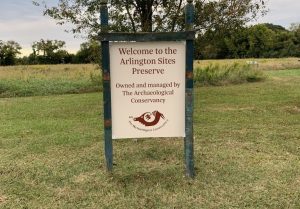The Conservancy’s Eastern Office is its newest. It was founded in 1997 in Washington D.C., though the location was moved to Frederick, Maryland in the 2000s. Due to challenging preservation conditions and a long period of post-contact historical land use, archaeological sites in the East are less visible than those in the Southwest or the Midwest, where there are standing ruins and mounds. Still, it was soon realized that the region holds tremendously important remains of sites from the Paleoindian through the historic industrial period.
The Eastern office has been headed by Robert Crisell, Donald Craib, Andrew Stout, and Kelley Berliner, who became the Eastern Regional Director in 2019. It is responsible for the region covering Maine through North Carolina. In 2022 additional portions of Pennsylvania were transferred to the Eastern Region following the move of the Midwest office farther west. The office is now responsible for the management of over 80 archaeological preserves.
The bulk of the sites protected and managed in the Eastern Region are associated with pre-contact American Indian peoples, given the lack of protections offered to this type of site. That said, the East has a long tradition of historical archaeology, which has prompted the acquisition of sites dating to later periods to reflect the archaeological record of all communities more accurately in this part of the country. Preserves include sites that span in diversity from the Nevers Preserve in New Hampshire which has substantial occupation dating to the Paleoindian Period, to the New England Hebrew Farmers of the Emanuel Society Preserve, which contains the remains of a 19th-20th century Jewish community. Of the 80 preserves in the East, 25 are listed on the National Register of Historic Places or are National Landmarks.
A sampling of acquisition in the Eastern region includes:
- Sharrow & Bingham Preserves, Maine, acquired 1999: Two multicomponent sites dating from the Early Archaic to Late Woodland. The sites have led to a revision of past models of human occupation in the area given their long occupations. Living floors and hearths have been uncovered along with points, plummets, grinding tools, ceramics. At Sharrow, the earliest evidence of squash in the northeast has been found dating to ca. 4000 B.C.E.
- Nevers Preserve, New Hampshire, acquired 1999: A Paleoindian tool manufacturing site that has produced fluted points, scrapers, and bifaces. The site was the first confirmed and one of the largest Paleo-Indian sites found in the region.
- New England Hebrew Farmers of the Emanuel Society Preserve, Connecticut, acquired 2022: Contains the remains, including stone foundations of a synagogue and mikveh, of a late-19th century Jewish settlement.
- Nemasket River Village Preserve, Massachusetts, easement acquired 2022: Archaeological deposits date from the Middle Archaic through the Late Woodland period and include a Wampanoag Village that dates to 1400 C.E. The site has an extremely high density of features, including post molds that represent at least 69 houses. The site was protected through a partnership between the Town of Middleborough, the Native Land Conservancy, and The Archaeological Conservancy. It is open to the public for passive use.
-

Lamoka Lake Preserve in New York is the location of an Archaic site excavated by William Richie in the 1920s.
Lamoka Lake Preserve, New York, acquired 2006: One of the key sites in American archaeology located in the Finger Lakes region of Central New York. William Ritchie conducted the first systematic excavations at the site in the 1920s which resulted in his identifying and naming the Lamoka culture and its projectile point type. Ritchie’s work also marked the first use of the term “Archaic” in American archaeology and the site was recognized as a National Historic Landmark on January 20, 1961.
- Garoga Preserve, New York, acquired 2015: Contains a 16th century Mohawk village, including the remains of nine longhouses, almost 100 pit features, a double palisades, and numerous fire hearths. Artifacts found include some of the earliest evidence of European trade goods in the Mohawk Valley.
- Jack’s Reef Preserve, New York, acquired 2022: A site known for its intense occupation during the Middle Woodland period as well as the density of artifacts revealed during archaeological excavations. William Ritchie’s work at the site resulted in the naming of types of projectile points and pottery, such as Jack’s Reef Points, terms still used today.
- Fort Littleton Preserve, Pennsylvania, acquired 2005 and 2021: Fort Littleton was one of a series of forts that were constructed across Pennsylvania during the French and Indian War. In addition to the fort itself, archaeology has demonstrated that there are deposits outside of the fort.
- Kings Quarry Preserve, Pennsylvania, acquired 2006: The quarry is believed to be one of the last undisturbed jasper quarries in the Mid-Atlantic region and contains intact prehistoric quarry pits, some of which were found to be over 30 feet deep. The site contains layers of jasper flakes and debitage and has evidence of use from the Paleo-Indian to the Late Woodland period.
- Ebbert Spring Archaeological Preserve and Heritage Park, Pennsylvania, acquired 2010 and 2017: The pre-contact and historic sites are focused around Ebbert Spring, a highly productive freshwater spring. In addition to dense occupation by Native peoples, the land was reoccupied during the historic period and contains 18th-century buildings. The preserve operates as a passive use park that is open to the public.
- Kippax Plantation Preserve, Virginia, acquired 2006: A 17th-20th century historic plantation settled by Robert Bolling. Kippax functioned as a trading center where European traders bartered beads and other European items for furs from Native Americans. Thousands of glass trade beads, as well as other European and Native American artifacts have been recovered at Kippax. The site also contains a 17th-18th African American enslaved persons’ quarter.
- Ely Mound Preserve, Virginia, acquired 2008: One of only two standing Mississippian Mounds left in the State of Virginia. Originally excavated in the 1870’s by the Peabody Museum, the information recovered from site went towards disproving the “mound builder” myth.
- Thunderbird Preserve, Virginia, acquired 2011: The site has made significant contributions to our understanding of Paleoindian culture in the eastern United States since its discovery in the late 1960s. Contains a stratified cultural sequence from Paleoindian through the end of the Early Archaic. Work also uncovered the post-mold pattern for a house believed to be one of the oldest known structures in North America.
-
Arlington Preserve, Virginia, acquired 2021: The preserve contains several sites, including American Indian occupation, early 17th-century features that may be associated with the Virginia Company, and the remains of the Custis family mansion that was built in 1670. The property is open to the public.
- Paul Gardner Preserve at Contentnea Creek, North Carolina, acquired 2007: A multi-component site associated with Mount Pleasant and Tuscarora peoples. Excavations revealed almost 3,000 features including post molds, storage pits, hearths, and even canine burials, in addition to a wide array of Middle and Late Woodland Period pottery, and lithic material.





